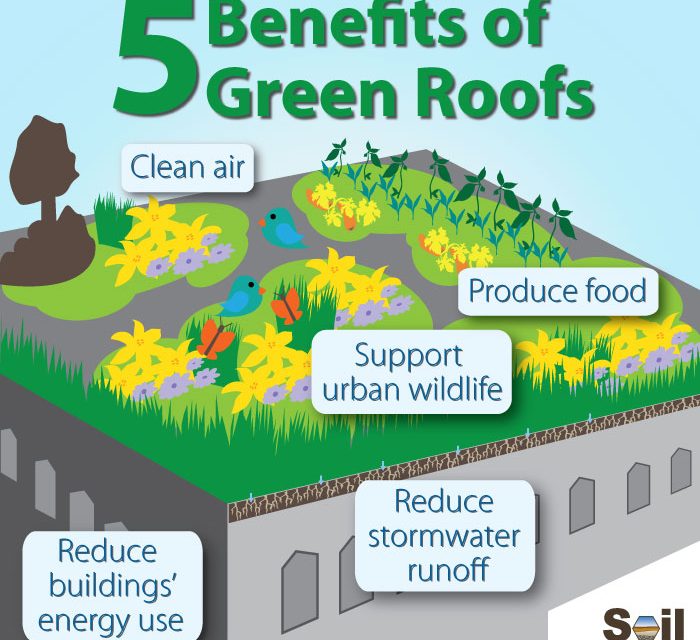Benefits of Green Roofs
Green roofs, also known as living roofs or eco-roofs, have become increasingly popular in recent years due to their numerous environmental and economic benefits. In this article, we will explore the advantages of green roofs and why they are a sustainable solution for urban areas.
Improved Stormwater Management
One of the key benefits of green roofs is their ability to manage stormwater effectively. Traditional roofs contribute to stormwater runoff, which can overwhelm drainage systems and lead to flooding. Green roofs, on the other hand, absorb rainwater and release it slowly, reducing the strain on infrastructure. This helps to mitigate the risk of flooding and prevents water pollution by filtering out pollutants.
Enhanced Energy Efficiency
Green roofs provide excellent insulation, reducing the need for artificial heating and cooling. By creating an additional layer of vegetation, they help to regulate indoor temperatures, keeping buildings cooler in summer and warmer in winter. This reduces energy consumption, lowers utility bills, and contributes to a more sustainable built environment.
Urban Heat Island Effect Mitigation
Urban areas often experience the urban heat island effect, where temperatures are significantly higher compared to surrounding rural areas. Green roofs can help mitigate this effect by absorbing solar radiation and releasing it as evapotranspiration. This process cools the surrounding air and reduces the overall temperature, making cities more comfortable and reducing the demand for air conditioning.
Improved Air Quality
Green roofs act as natural air filters, trapping dust particles and absorbing pollutants from the atmosphere. The vegetation on green roofs captures airborne pollutants and converts carbon dioxide into oxygen through photosynthesis. This not only improves air quality but also contributes to reducing greenhouse gas emissions, mitigating the impact of climate change.
Biodiversity and Habitat Creation
Green roofs provide an opportunity to create habitats for various plant and animal species, especially in urban areas where green spaces are limited. By incorporating native plants, green roofs can attract birds, butterflies, and insects, promoting biodiversity and supporting local ecosystems. This helps to restore balance to urban ecosystems and enhances the overall resilience of the environment.
Noise Reduction
Green roofs can also act as effective noise barriers, reducing sound transmission from outside. The layers of vegetation and substrate absorb and reflect sound waves, creating a quieter indoor environment. This is particularly beneficial for buildings located in noisy urban areas or near airports, improving the quality of life for occupants.

Green roofs offer a myriad of benefits, ranging from environmental sustainability to economic advantages. By implementing green roofs, we can improve stormwater management, enhance energy efficiency, mitigate the urban heat island effect, improve air quality, promote biodiversity, reduce noise pollution, and create a more sustainable and livable urban environment. Consider incorporating green roofs into your building projects to enjoy these benefits and contribute to a greener future.
Frequently Asked Questions
1. What are green roofs?
Green roofs are vegetated roof systems that are covered with plants and vegetation, providing a layer of living greenery on top of buildings.
2. What are the benefits of green roofs?
Green roofs offer numerous benefits, including:
Improved stormwater management
Reduced urban heat island effect
Enhanced air quality
Energy savings through improved insulation
Increased biodiversity and habitat creation
Noise reduction
Extended roof lifespan
Improved aesthetics and visual appeal
Increased property value
Potential for urban agriculture
3. How do green roofs help with stormwater management?
Green roofs absorb rainwater, reducing the amount of runoff that enters storm drains and overburdens the sewer systems. They act as natural sponges, retaining water and releasing it slowly over time.
4. How do green roofs reduce the urban heat island effect?
The vegetation on green roofs helps to cool the surrounding air by providing shade and releasing moisture through evapotranspiration, reducing the temperature of the roof surface and the immediate environment.
5. How do green roofs enhance air quality?
Green roofs absorb airborne pollutants and filter out particulate matter, helping to improve air quality in urban areas. The plants also release oxygen, contributing to a healthier atmosphere.
6. How do green roofs provide energy savings?
Green roofs act as an extra layer of insulation, reducing the need for heating in winter and cooling in summer. This can lead to significant energy savings and lower utility bills.
7. How do green roofs increase biodiversity?
Green roofs provide a habitat for plants, insects, birds, and other wildlife that may not otherwise thrive in urban environments. They contribute to the conservation of biodiversity and support local ecosystems.
8. How do green roofs reduce noise?
The layers of vegetation and substrate on green roofs help to absorb and block sound, reducing noise pollution from surrounding areas, such as traffic or construction sites.
9. How do green roofs extend roof lifespan?
The vegetation and protective layers of a green roof shield the waterproofing membrane from UV radiation, extreme temperatures, and physical damage, extending the lifespan of the roof and reducing maintenance costs.
10. How do green roofs increase property value?
Green roofs enhance the visual appeal of buildings, making them more attractive to potential buyers or tenants. They also provide additional usable space, such as rooftop gardens or recreational areas, increasing the overall value of the property.




